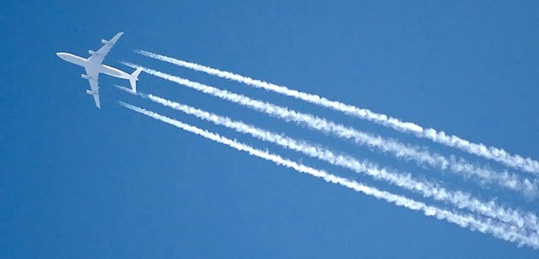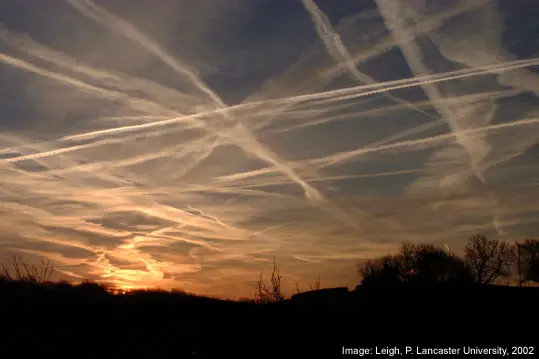Contrails are the white line-clouds often visible behind aircraft. These trails are triggered from the water vapour emitted by aircraft. Their optical properties depend on the particles emitted or formed in the aircraft plume and on the ambient atmospheric conditions. The radiative forcing effect depends on their optical properties and global cover, both of which are uncertain (IPCC, 1999).

Although it is less than 100 years since the first powered flight, the aviation industry has undergone rapid growth and has become an integral and vital part of modern society. In the absence of policy intervention, the growth is likely to continue. It is therefore highly relevant to consider the current and possible future effects of aircraft engine emissions on the atmosphere.
The main products of hydrocarbon fuel combustion are carbon dioxide and water vapor. At high altitudes this water vapor emerges into a cold environment, and the local increase in water vapor can push the water content of the air past saturation point. The vapor then condenses into tiny water droplets and/or deposits into ice particles . These millions of tiny water droplets and/or ice crystals form the vapour trail or contrails.
The energy drop (and therefore, time and distance) the vapor needs to condense accounts for the contrail forming some way behind the aircraft’s engines. The majority of the cloud content comes from water trapped in the surrounding air. At high altitudes, supercooled water vapor requires a trigger to encourage deposition or condensation. The exhaust particles in the aircraft’s exhaust act as this trigger, causing the trapped vapor to rapidly turn to ice crystals. Exhaust vapour trails or contrails usually occur at above 26,000 feet. where the temperature is below -40°C (-40°F).
Individual persistent contrails are routinely observed to shear and spread, covering large additional areas with cirrus cloud (Minnis et al., 1998). Aviation aerosol could also lead to changes in cirrus cloud (IPCC, 2007) and therefore contribute to radiative forcing. However, the IPCC admits that it is difficult to estimate radiative forcing of AIC (Aircraft Induced Cloudiness) at this point in history.

It had been hypothesized that contrails may affect the weather, reducing solar heating during the day and radiation of heat during the night by increasing the albedo. The suspension of air travel for three days in the United States after September 11, 2001 provided an opportunity to test this hypothesis. Measurements did show that without contrails the local diurnal temperature range (difference of day and night temperatures) was about 1 degree Celsius higher than immediately before.
“Climatologist David Travis (University of Wisconsin-Whitewater) and colleagues studying the contrail-free skies over the United States in the aftermath of the September 11 terrorist attacks, when flights over U.S. airspace were grounded. They compared satellite imagery collected September 11-13 with 30 years of cloud-cover data and assembled a history of the temperatures across North America at the same time of year for the same period.
When they compared the 30-year record to temperature readings for September 2001, they found that contrails are narrowing the range of temperature between day and night, making average day cooler and average nights warmer than would otherwise occur.
The contrast between daytime and nighttime temperatures grew from 3 to 5 degrees Fahrenheit (1.5 to 2.5 degrees Celsius) larger under the clear skies following September 11. Regions where contrails are usually present showed the greatest change.” (http://www.ucar.edu/news/features/clouds/)
